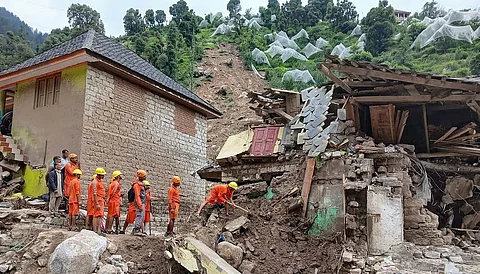

Himachal Pradesh faces severe monsoon challenges, with 184 lives lost and Rs 1,714 crore in damages due to heavy rains.
The Supreme Court's warning highlights administrative negligence and climate change indifference.
Mandi, Kullu, and Una districts are worst hit, with cloudbursts and landslides causing widespread devastation. Experts link the disasters to rising temperatures and changing rainfall patterns.
“If things proceed, the way they are as on date, then the day is not far when the entire State of HP may vanish in thin air from the map of the Country.” This harsh comment of the Supreme Court has once again exposed not only the administrative negligence and unplanned development work on the increasing disasters in Himachal Pradesh but has also exposed the governments’ indifference towards climate change.
This can be estimated from the fact that in just about one-and-a-half months, 184 people have lost their lives in the state due to heavy rains, while economic losses of about Rs 1,714 crore have occurred.
According to official data of the Himachal Pradesh Revenue Department, till August 4, there were incidents of cloudburst at 28 places in the state. There were also 51 incidents of flash floods and landslides at 45 places, all of which badly affected normal life.
Himachal has suffered the highest losses for the second time in five years during the 2025 monsoon season. And there are still two months of monsoon left.
In the monsoon season of 2021, 476 people died and there was a loss of Rs 1,151 crore. In 2022, there were 276 deaths and a loss of Rs 939 crore. In 2023, there were 441 deaths and a loss of Rs 12,000 crore, while in 2024, there were 174 deaths and a loss of Rs 1,613 crore.
Mandi, Kullu and Una districts have been the most affected this monsoon. Apart from these, incidents of floods and landslides are continuously happening in other areas as well.
Last week, a cloudburst in Mandi town caused extensive damage and three people died in the Jail Road area, one of the poshest locations of the city. The dam of Malana Power Project in Kullu has suffered extensive damage.
Mandi district was the biggest centre of monsoon havoc. Many incidents of cloudburst took place especially in the Janjheli area, where more than 1,000 houses were damaged. In Road Panchayat of Janjheli, 25 families have lost their homes due to the havoc of natural disasters.
Hetram of Road Panchayat told Down to Earth that he has never seen such a terrible situation in his entire lifespan of 50 years. Many people in the village have lost their houses and entire lands. Many are now facing a livelihood crisis.
Interestingly, the rainfall has been slightly more than average across the entire state. But in some districts, this is not the case. According to the figures of Meteorological Center, Shimla, 11 per cent more rainfall than average has been recorded in the state so far. A total of 439 mm of rain has fallen in the state while the normal amount is 396 mm.
Shimla, Mandi, Kullu and Una districts have received more than average rain. Mandi district has received 53 per cent more rain this monsoon. A total of 947 mm of rain was recorded, while the normal rainfall is 620 mm. Shimla has received 62 per cent more rain than normal i.e. 571 mm. Kullu has received 43 per cent and Una 45 per cent more rain.
Mandi received 574 mm (49 per cent more than average) rain in July, Shimla 357 mm (70 per cent more than average), Una 369 mm (12 per cent more than average) and Kullu 230 mm (25 per cent more than average) of rain. This excessive flood and rise in ground water level has not only accelerated the incidents of landslides, but the rivers are also in spate, which has increased the graph of disasters.
Why is this happening? Experts attribute this to the increasing heat in the region. Sunil Dhar, professor and dean of the Department of Life Sciences at Jammu Central University, told DTE that climate change is the biggest reason behind the changing rainfall pattern and cloudburst incidents.
He said this time the average temperature in Himachal was the highest in the last 25 years. “This year an extraordinary increase in temperature was observed. When hot and moist air rises rapidly and condenses on reaching cold heights, it causes sudden and heavy rain. This is called torrential rain. This process is more intense in the Himalayan valleys, as the hot air rises up along the mountains. As a result, excessive rainfall occurs in a very short time, sometimes even up to 100 mm in an hour,” said Dhar.
Ravindra Sharma, a farmer from Jankor Panchayat in Una district, told DTE that his entire polyhouse, farming machinery and the ripe cucumber crop standing in the polyhouse were completely washed away in the rain two days ago. Sharma said that if memory served him right, such heavy rains had last occurred in 1988.
Naresh Thakur, 70, of Mandi district said, “Now, the rains have started scaring us. The rains have started to fall so heavily that people are scared and nervous. In the last few years, a huge change in the weather has been observed and the number of natural disasters is increasing year after year, which is also increasing anxiety among people.”
Due to increasing disasters caused by climate change in the state, Chief Minister Sukhvinder Singh Sukhu went to Delhi and met Union Environment, Forest and Climate Change Minister Bhupendra Yadav. He gave detailed information about the damage caused in the state and demanded allocation of forest land for the rehabilitation of landless people.